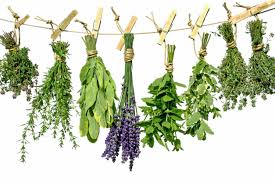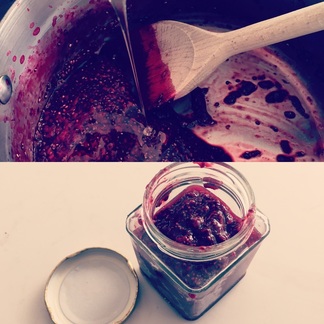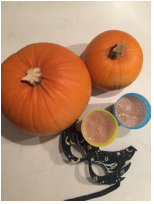 Herbs and spices are such an important part of food and nutrition. As well as providing taste and colour to food many have numerous nutritional benefits as they are full of phytonutrients. Phytonutrients (sometimes referred to as 'phytochemicals') are compounds in all plants which protect it and help it grow. These are the things that alongside vitamins and minerals offer us health benefits. You may have heard of some specific phytochemicals such as tannins, caffeine, phytates and reservatrol. Some of the best known culinary herbs with superb health benefits include basil, rosemary, thyme, sage, cinnamon, cardamon, liquorice, chamomile, oregano, ginger and fennel. Probably the easiest and safest way to consume most culinary herbs is through a infusion (or a tea). This requires you to pour boiling water over dry or fresh herbs (normally 1 heaped teaspoon, or 1 teabag) and leave to steep for 10 – 15 minutes (preferably with a lid or a cover to avoid the loss of volatile oils). Drink three times daily for health benefits. Here are some healthy herbals teas and why they can benefit you: Chamomile: calming and anti-inflammatory. Great for digestive issues especially when caused by stress or anxiety Cinnamon: Very soothing for diarrhoea. Warming for those with poor circulation Fennel: for gas bloating and IBS. Also good for breastfeeding mothers as it increases breast milk production. Liquorice: anti-inflammatory and soothing for the stomach, good for constipation as a mild laxative. Not recommended for those with high blood pressure Nettle: very good for seasonal allergies Peppermint: for gas, bloating and IBS Sage: for menopause (hot flushes), and soothing to sore throats Spearmint: may be useful for conditions with high androgens such as PCOS and acne (**N.B. some herbs even taken as a tea, should be used with caution or on advice if pregnant or on medication) But adding herbs to food is just as easy and can really boost flavour of so many dishes. Here are three of my favourite culinary spices. Curries from Asia famously contain many herbs and spices and one of the most interesting and heavily researched is turmeric which is becoming more and more used in therapeutic doses for its natural anti-inflammatory actions so excellent for joint pain or inflammatory conditions. I also love adding fresh or fried turmeric to scrambled eggs (always with black pepper which helps with the absorption) or to a cup of bedtime golden milk (see recipes). Cardamom is another lovely spice known for its anti-carcinogenic properties, as a digestive aid and in relation to helping urinary infections. Its also high in manganese and iron. Again this is quite often used in South East Asian and Scandinavian cooking. But cardamom has a natural affinity with sweet so I quite often grate a little into cakes or puddings, especially anything chocolate. Fantastic in hot chocolate (see recipes). Lastly, ginger. Beautiful, powerful, unforgettable ginger is wonderful as it can be used in curries to add heat (many Indian and Thai curries use ginger as standard), in sweet dishes or cakes and in reality is gorgeous just on its own in some boiling water. Ginger contains a compound called gingerol which is what gives it its anti-inflammatory properties and also its anti-nausea merits. Ginger and lemon in hot water first thing in the morning throughout winter. Can't beat it.
0 Comments
 Oh chia seeds, how do I love thee... We are just coming into major fruit picking season here in the SE of England. Specifically raspberries, blueberries, cherries and plums in August with blackberries, sloe berries to follow shortly....I could go on. Jam making was something I loved as a child and some of my most cherished memories include eating just made warm blackberry jam on fresh bread. BUT, anyone that has ever made jam will know it is typically made with fresh sugar. Firstly, to sweeten as some berries can be rather tart, secondly to gel the fruit together into the jammy consistency and lastly the sugar acts as a preservative giving most jams a long shelf life. I found some great recipes for jam which didn't include a whole heap of refined sugar (normally pectin sugar is used in traditional jam making) and best of all they include chia seeds which act in place of the pectin to bind the fruit together giving you jam. Chia seeds are often spoken about as a superfood. And they are rather super. Full of protein and fibre, they are also high in magnesium (a mineral many people are often found to be deficient in) plus they are a source of ALA omega 3. INGREDIENTS
RECIPE Chop the fruit and add to a pan. Cook on a medium heat until the fruit starts to break down, add a little water if necessary. Mash the fruit, then add the honey. Allow to cool before adding the chia seeds. Stir in thoroughly and then add to sterilised jars and refrigerate allowing the jam to set. This should keep in the fridge for 5-7 days. Delicious on crumpets....  Last week I posted a recipe for an Ayurverdic favourite: golden milk. This week I thought I'd give you my take on a healthy hot chocolate. I always give this to the kids and really like the idea of giving them a treat whilst boosting their systems. Raw cacao sounds exotic but in reality its not. It is the main ingredient found in chocolate, but you will find a lot of commercial UK chocolate doesn't actually contain enough to actually define itself as 'chocolate'! Cacao is obtained by cold pressing cocoa beans. Cocoa powder is cacao that has then been roasted which reduces its overall nutritional value. You can get raw cacao in lots of supermarkets. I use it in all my baking to make anything chocolatey combined with something sweet and unrefined like honey, maple syrup or dates (raw cacao is quite bitter on its own). One tub goes a long way so if you do bake a lot you will find this more economical than buying cooking chocolate each time. Cacao is high in magnesium (nature's relaxant mineral) iron (necessary for energy and oxygen transport around the body) and the potent antioxidant reservatrol. Interestingly, it is unknown whether heating or cooking with cacao destroys some of its nutrient value. But it is known that dairy inhibits the antioxidants in cacao so best to steer clear of milk-cacao combo's. INGREDIENTS:
RECIPE: Add the milk, turmeric powder plus raw cacao with a dash of black pepper, ¼ tsp of coconut oil and maple syrup to taste. Bring to just below boiling point, stirring constantly. Add cinnamon and grated cardamom. Serve in a mug, enjoy the comfort and goodness! A lovely alternative to hot chocolate and great to give to children too. The glowing benefits of golden milk:
Turmeric is a natural anti-inflammatory, antioxidant, antibiotic, analgesic, anti-arthritic, antiseptic. It is good for chronic inflammatory conditions such as asthma, eczema, psoriasis and auto-immune conditions and for pain relief and post operatively (http://www.ncbi.nlm.nih.gov/pubmed/21671126). Great for digestion and helps reduce gas and bloating. It is reported to help fight arthritis, cancer and viral infections: (http://www.ncbi.nlm.nih.gov/pubmed/22921746). There are over 90 constituents in turmeric, the most famous of which is curcumin. Turmeric has long been held in value for its medicinal properties and is regularly used in Ayurverdic medicine but has come under a lot of scientific scrutiny from the western medical profession for its therapeutic uses. INGREDIENTS:
RECIPE: Add the milk and turmeric paste into a pot and cook on medium heat. Add the black pepper which helps with the absorption of the turmeric, plus the ginger/cinnamon/cardamom to taste, some other great anti-inflammatories. Stir constantly until just before boiling. Remove from heat. When cooler, add the oil(s) and honey to taste. The coconut oil supplies you with healthy fats and further increases turmeric absorption. The drink should be a lovely golden colour, hence its name. |
AuthorLouise Cullen Archives
October 2020
Categories
All
|
 RSS Feed
RSS Feed
